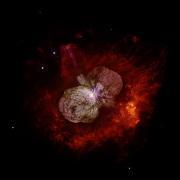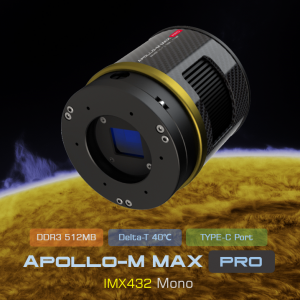The American Association of Variable Star Observers (AAVSO) is an international non-profit organization of variable star observers whose mission is to enable anyone, anywhere, to participate in scientific discovery through variable star astronomy. The organization will host its Spring Meeting June 13 – 16 in Toronto, Canada.
The AAVSO was founded in 1911 to coordinate variable star observations—made largely by amateur astronomers—for Harvard College Observatory. The AAVSO was incorporated in the Commonwealth of Massachusetts in 1918 as a non-profit scientific and educational organization. Today, as an independent, private research organization headquartered in Cambridge, Massachusetts, with active participants in more than 100 countries, and an archive of over 34 million variable star observations, it is the world’s largest association of variable star observers.
Membership in the AAVSO is open to anyone—professionals, amateurs, and educators alike—interested in variable stars and in contributing to the support of valuable research.
Professional astronomers have neither the time nor the telescopes needed to gather data on the brightness changes of thousands of variables, and amateurs make a real and useful contribution to science by observing variable stars and submitting their observations to the AAVSO International Database.
AAVSO meetings provide members, observers, and interested guests with an opportunity to present their own research on variable stars and related topics. At each meeting a professional astronomer involved in variable star-related research is invited to give a guest lecture on his or her area of expertise. Time is allotted for an open discussion period where those in attendance are welcome to exchange ideas about observing, new techniques, problems, solutions, or any other topic that may come up.
What are Variable Stars?
Variable stars are stars that change brightness. The brightness changes of these stars can range from a thousandth of a magnitude to as much as twenty magnitudes over periods of a fraction of a second to years, depending on the type of variable star. Over 150,000 variable stars are known and catalogued, and many thousands more are suspected to be variable.
There are a number of reasons why variable stars change their brightness. Pulsating variables, for example, swell and shrink due to internal forces. An eclipsing binary will dim when it is eclipsed by a faint companion, and then brighten when the occulting star moves out of the way. Some variable stars are actually extremely close pairs of stars, exchanging mass as one star strips the atmosphere from the other.

The different causes of light variation in variable stars provide the impetus for classifying the stars into different categories. Variable stars are classified as either intrinsic, wherein variability is caused by physical changes such as pulsation or eruption in the star or stellar system, or extrinsic, wherein variability is caused by the eclipse of one star by another, the transit of an extrasolar planet, or by the effects of stellar rotation.
An example of a type of variable star are Cataclysmic variables, which as the name implies, are stars which have occasional violent outbursts caused by thermonuclear processes either in their surface layers or deep within their interiors. The majority of these variables are close binary systems, their components having strong mutual influence on the evolution of each star. It is often observed that the hot dwarf component of the system is surrounded by an accretion disk formed by matter lost by the other, cooler, and more extended component.
Shown in Image 1 is a Hubble Space Telescope image showing Eta Carinae and the bipolar Homunculus Nebula which surrounds the star. The Homunculus was partly created in an eruption of Eta Carinae, the light from which reached Earth in 1843. Eta Carinae itself appears as the white patch near the center of the image, where the 2 lobes of the Homunculus touch.
Why do AAVSO Members Observe Variable Stars?
The science of variable star astronomy teaches us about one important part of the universe — the stars. Stars are the primary engines of cosmic evolution, particularly in the creation of elements heavier than hydrogen and helium which make up us and the world that we live in.
Further, stars and their systems of planets are the only likely places we will find life in the universe; by studying stars (including our own Sun), we are also learning about possible abodes for life.
Research on variable stars is important because it provides information about stellar properties, such as mass, radius, luminosity, temperature, internal and external structure, composition, and evolution. Some of this information would be difficult or impossible to obtain any other way. In many cases, it is the nature of the variability that provides the clues to the answers. This information can then be used to understand other stars.
Variable stars need to be systematically observed over decades in order to determine their long-time behavior. Amateurs play an important part on tracking data on the brightness changes of thousands of variable stars. Amateur astronomers utilize visual, photographic, photoelectric, and CCD techniques who are making a real and highly useful contribution to science by observing variable stars and submitting their observations to the AAVSO International Database.
This important data is needed to analyze variable star behavior, to schedule satellite observations of certain stars, to correlate data from satellite and ground-based observations, and to make computerized theoretical models of variable stars possible.
Variable stars play a crucial role in our understanding of the universe. Cepheid variables have played a major part in determining distances to far-away galaxies and determining the age of the Universe.
Mira variables give us a glimpse into the future evolution of our own star, the Sun. Accretion disks in cataclysmic variables help us to understand larger scale disk behavior, like the activity inside active galaxies with supermassive black holes. Supernovae have led us to the surprising realization that the expansion of the Universe is accelerating.
Even the search for extra-terrestrial life is illuminated by variable stars. Transiting extrasolar planets provide clues into the processes of planetary formation, and the very stuff life as we know it is made of comes from the hearts of stars that explode in the final stages of their evolution.



